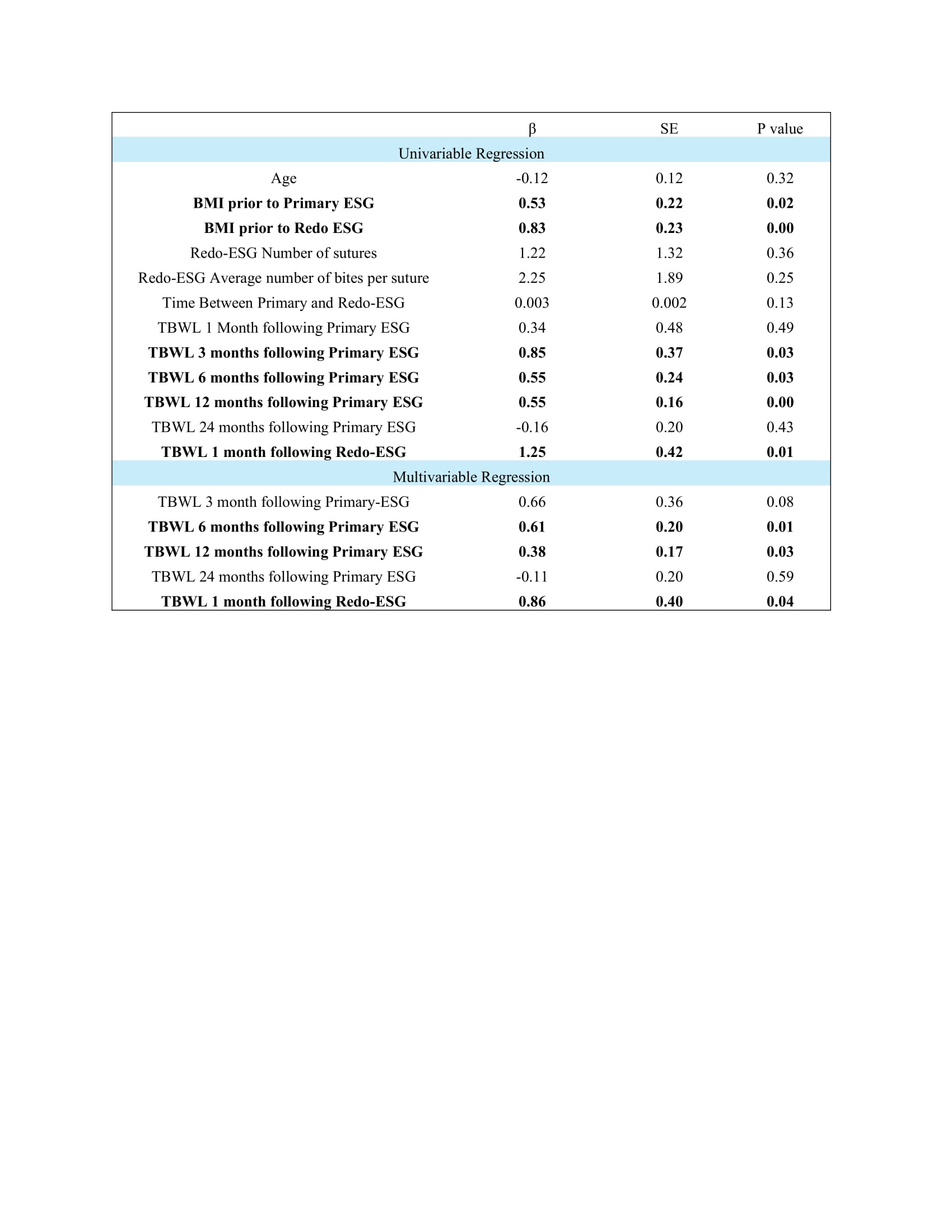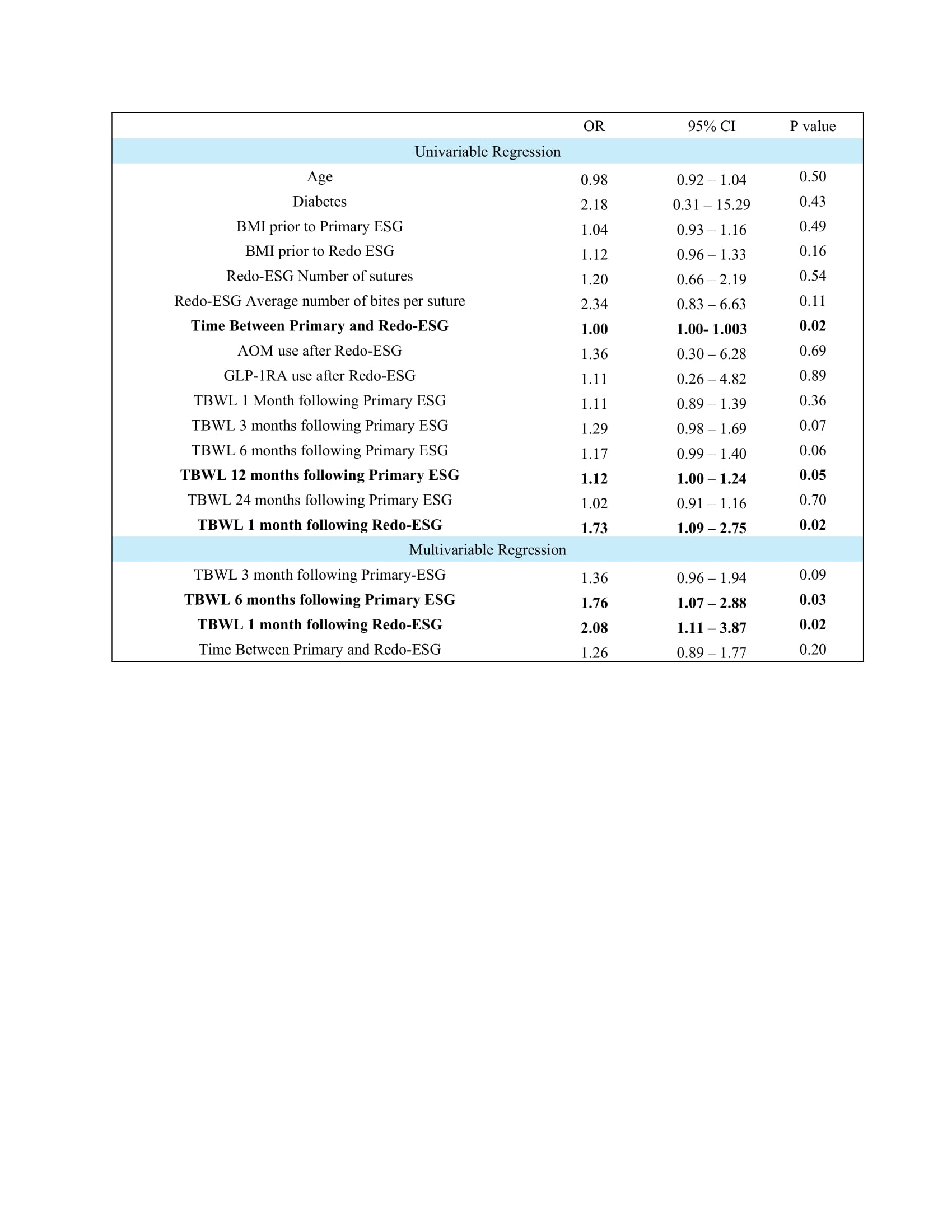Monday Poster Session
Category: Diet, Nutrition, and Obesity
P2706 - Predictors of Weight Loss Following Endoscopic Re-Suturing Post Endoscopic Sleeve Gastroplasty
Monday, October 27, 2025
10:30 AM - 4:00 PM PDT
Location: Exhibit Hall
- KL
Kevin Lin, MD (he/him/his)
NewYork-Presbyterian/Columbia University Irving Medical Center
New York, NY
Presenting Author(s)
Kevin Lin, MD1, Benjamin Lebwohl, MD, MS2, Reem Z.. Sharaiha, MD, MSc3
1NewYork-Presbyterian/Columbia University Irving Medical Center, New York, NY; 2Columbia University Irving Medical Center, New York, NY; 3Weill Cornell Medical College, New York, NY
Introduction: Endoscopic sleeve gastroplasty (ESG) is an effective and durable means for obesity treatment by reducing gastric body volume and impairing gastric emptying. However, a subset of patients experience weight regain or have a plateau in weight loss. The best management strategies for these patients remains unclear. Redo-ESG (R-ESG) is an option to treat weight regain and has been shown to be superior to anti-obesity medications (AOM) alone. While factors associated with weight loss following ESG have been established, predictors of weight loss following R-ESG have not been well studied.
Methods: We performed a retrospective analysis of a prospective database including data on all R-ESG procedures performed from January 2013 to May 2024. Inclusion required patients be at least 18 years of age with 2 year follow up data following primary-ESG (P-ESG) and 1 year follow up after R-ESG. Baseline demographic data, medical history, surgical history, procedure factors, medication use, and weight parameters were extracted through chart review. Our primary outcome was factors associated with TBWL 6 months following R-ESG.
Results: A total of 53 patients were included with a median age of 42 (IQR 32-52), of which 70% were female. The mean time between P-ESG and R-ESG was 963 days (SD 597.21). 53% of patients were administered a glucagon-like peptide 1 receptor agonist (GLP-1RA) following R-ESG. On univariable regression, greater TBWL at 6 months post-P-ESG and higher BMI prior to P-ESG and R-ESG were associated with greater TBWL at 6 months following R-ESG on univariate analysis (Table 1). Additionally, TBWL at 1 month following R-ESG was associated with TBWL at 6 months following R-ESG (Table 1). These variables remained significantly associated with TBWL at 6 months following R-ESG after adjusting for age, sex, BMI, number of sutures used during R-ESG, and use of GLP-1RA and other AOM following R-ESG (Table 1). Clinically significant TBWL, defined as TBWL >10%, at 6 months following R-ESG was associated TBWL at 6 months following P-ESG on multivariable logistic regression after adjusting for these same covariates (Table 2).
Discussion: This study identifies factors associated with TBWL following R-ESG. Greater TBWL following P-ESG and early weight loss following R-ESG was associated with 6-month weight loss following R-ESG. These findings mirror predictors of weight loss following P-ESG. This study may help identify patients who will respond to revisional therapy.

Figure: Table 1: Regression analysis of predictors of total body weight loss (TBWL) 6 months following Redo-Endoscopic sleeve gastroplasty (R-ESG)
BMI, body mass index; SE, standard error; TBWL, total body weight loss; ESG, endoscopic sleeve gastroplasty
P value <0.05 are bolded

Figure: Table 2: Logistic regression analysis of predictors of clinically significant total body weight loss, defined as total body weight loss >10%, 6 months following Redo-Endoscopic sleeve gastroplasty (R-ESG)
BMI, body mass index; CI, confidence interval; TBWL, total body weight loss; ESG, endoscopic sleeve gastroplasty
P value <0.05 are bolded
Disclosures:
Kevin Lin indicated no relevant financial relationships.
Benjamin Lebwohl indicated no relevant financial relationships.
Reem Sharaiha: Boston Scientific – Consultant. Cook Medical – Consultant. Olympus – Consultant. Surgical Intuitive – Consultant.
Kevin Lin, MD1, Benjamin Lebwohl, MD, MS2, Reem Z.. Sharaiha, MD, MSc3. P2706 - Predictors of Weight Loss Following Endoscopic Re-Suturing Post Endoscopic Sleeve Gastroplasty, ACG 2025 Annual Scientific Meeting Abstracts. Phoenix, AZ: American College of Gastroenterology.
1NewYork-Presbyterian/Columbia University Irving Medical Center, New York, NY; 2Columbia University Irving Medical Center, New York, NY; 3Weill Cornell Medical College, New York, NY
Introduction: Endoscopic sleeve gastroplasty (ESG) is an effective and durable means for obesity treatment by reducing gastric body volume and impairing gastric emptying. However, a subset of patients experience weight regain or have a plateau in weight loss. The best management strategies for these patients remains unclear. Redo-ESG (R-ESG) is an option to treat weight regain and has been shown to be superior to anti-obesity medications (AOM) alone. While factors associated with weight loss following ESG have been established, predictors of weight loss following R-ESG have not been well studied.
Methods: We performed a retrospective analysis of a prospective database including data on all R-ESG procedures performed from January 2013 to May 2024. Inclusion required patients be at least 18 years of age with 2 year follow up data following primary-ESG (P-ESG) and 1 year follow up after R-ESG. Baseline demographic data, medical history, surgical history, procedure factors, medication use, and weight parameters were extracted through chart review. Our primary outcome was factors associated with TBWL 6 months following R-ESG.
Results: A total of 53 patients were included with a median age of 42 (IQR 32-52), of which 70% were female. The mean time between P-ESG and R-ESG was 963 days (SD 597.21). 53% of patients were administered a glucagon-like peptide 1 receptor agonist (GLP-1RA) following R-ESG. On univariable regression, greater TBWL at 6 months post-P-ESG and higher BMI prior to P-ESG and R-ESG were associated with greater TBWL at 6 months following R-ESG on univariate analysis (Table 1). Additionally, TBWL at 1 month following R-ESG was associated with TBWL at 6 months following R-ESG (Table 1). These variables remained significantly associated with TBWL at 6 months following R-ESG after adjusting for age, sex, BMI, number of sutures used during R-ESG, and use of GLP-1RA and other AOM following R-ESG (Table 1). Clinically significant TBWL, defined as TBWL >10%, at 6 months following R-ESG was associated TBWL at 6 months following P-ESG on multivariable logistic regression after adjusting for these same covariates (Table 2).
Discussion: This study identifies factors associated with TBWL following R-ESG. Greater TBWL following P-ESG and early weight loss following R-ESG was associated with 6-month weight loss following R-ESG. These findings mirror predictors of weight loss following P-ESG. This study may help identify patients who will respond to revisional therapy.

Figure: Table 1: Regression analysis of predictors of total body weight loss (TBWL) 6 months following Redo-Endoscopic sleeve gastroplasty (R-ESG)
BMI, body mass index; SE, standard error; TBWL, total body weight loss; ESG, endoscopic sleeve gastroplasty
P value <0.05 are bolded

Figure: Table 2: Logistic regression analysis of predictors of clinically significant total body weight loss, defined as total body weight loss >10%, 6 months following Redo-Endoscopic sleeve gastroplasty (R-ESG)
BMI, body mass index; CI, confidence interval; TBWL, total body weight loss; ESG, endoscopic sleeve gastroplasty
P value <0.05 are bolded
Disclosures:
Kevin Lin indicated no relevant financial relationships.
Benjamin Lebwohl indicated no relevant financial relationships.
Reem Sharaiha: Boston Scientific – Consultant. Cook Medical – Consultant. Olympus – Consultant. Surgical Intuitive – Consultant.
Kevin Lin, MD1, Benjamin Lebwohl, MD, MS2, Reem Z.. Sharaiha, MD, MSc3. P2706 - Predictors of Weight Loss Following Endoscopic Re-Suturing Post Endoscopic Sleeve Gastroplasty, ACG 2025 Annual Scientific Meeting Abstracts. Phoenix, AZ: American College of Gastroenterology.

